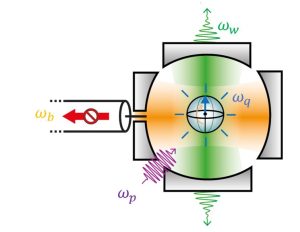Single-photon detectors, widely used in optical frequencies, have led to significant technological advances far beyond fundamental physics. Applications such as fluorescence microscopy and LIDAR are notable examples. Extending photon counting to a much broader range of frequencies has and continues to be a major goal in the community. Microwave frequencies, typically between 1 and 20 GHz, which are five orders of magnitude lower in energy, are essential in electronics and telecommunications. At cryogenic temperatures (below 100 mK), it is possible to achieve almost perfect blackness in this part of the spectrum. Thus, similar to the optical range, photon counting becomes an extremely sensitive detection method, allowing the distinction of a single photon against a quantum vacuum background, without the fundamental sensitivity limit inherent in the detection of electromagnetic field quadratures. However, the low energy of microwave photons complicates the transposition of optical technologies, which are based on the photoelectric effect and the absorption of photons by materials with an energy gap. This challenge is due to the lack of suitable materials with sufficiently low gaps to effectively respond to microwave frequencies.
In 2018 we developed an innovative superconducting microwave photon counting based on the principles of quantum information processing rather than on material physics. This has placed us in a comfortable position, as there have been relatively few alternative proposals for microwave photon counting since. This is likely due to the robustness and simplicity of implementing our detection scheme. Our research program remains very dynamic, as fundamentally the ultimate sensitivity of photon detection is not limited by the laws of quantum mechanics. Indeed, the lower the dark noise for a given efficiency, the better the sensitivity.
We are now working on designing a new range of detectors. Since the basic principle of our photon detection is based on quantum information processing, it is possible to add a level of error correction by introducing redundancy into the detection mechanism. Specifically, the detection principle in operation is non-destructive for the photon; the photon is simply re-emitted at a different frequency by the device. It is thus possible to cascade several devices to repeat the detection multiple times. If two detectors are cascaded, a click is recorded only if both detectors click simultaneously, which helps to eliminate the vast majority of the intrinsic dark noise of the detector but at the expense of efficiency. With three cascaded detectors, a majority vote system can improve both dark noise and efficiency simultaneously. It is important to note that this quantum cascading can be done on-chip and coherently, only moderately increasing the complexity of the chip (especially compared to processors developed for quantum computing).
Today, a two-qubit proof of principle is in the testing phase, and the results are extremely encouraging. A dark noise of 3 c/s is measured for an efficiency of 25%. Extrapolating these preliminary results, it is conceivable to achieve a sensitivity of the order of 10-23 W/√Hz. As a reminder, since the measurement time is inversely proportional to the square of the sensitivity, the two orders of magnitude gain from this research program allows for a 104 factor improvement in measurement time. This makes it possible to access new physical phenomena, for example in magnetic resonance and in the search for dark matter.




